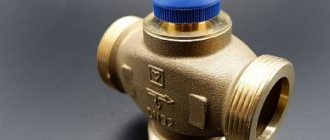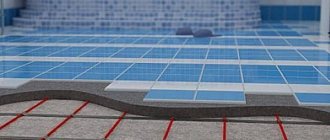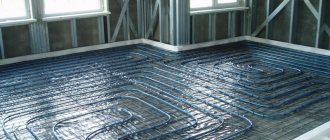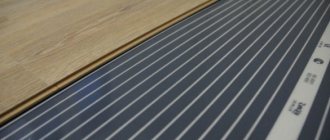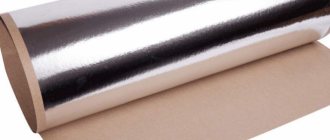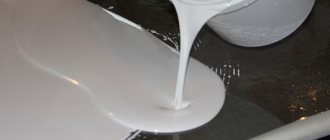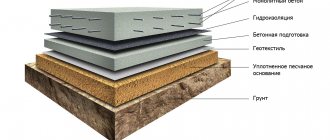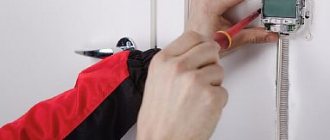Home » Equipment » Warm floor
When installing heated floors laid in a concrete screed, experts recommend using reinforcement, which will significantly increase the strength of the entire structure.
Heated floor mesh
For this purpose, a mesh for underfloor heating is used, which will help securely fix the heating elements of the structure, thereby increasing their efficiency and performance properties.
Purpose of the grid
Is reinforcing mesh needed when pouring heated floors? Laying is not mandatory, but experts advise using it. After all, with its help, you can get a number of positive effects, such as:
- Increased strength and durability - it will protect the structure from deformation when the system heats up, and therefore from the formation of cracks.
- Uniform distribution of load across the base from furniture and finishing coating.
- Reducing cement consumption when preparing the mixture.
- Reducing the thickness of the screed, but this does not affect the strength properties of the device.
- Possibility of fixing heating elements to it.
- Increased system performance. Does not allow the heating cable or pipes through which the coolant circulates to lie close to the base. After all, cement mortar must penetrate into the space between them, this increases the heat transfer of the floor.
In addition, the use of a reinforced structure allows you to obtain the most even surface.
Fiber fiber
The principle of using fiber as reinforcement for screeds is significantly different from mesh reinforcement.
Fiber - fibers of basalt, glass, polypropylene, metal, in dry form are added to the ingredients of mortar or concrete. When the floor hardens, the fiber gives the effect of a durable monolith, protects the floor surface well from microcracks, but will not save you from significant mechanical impact.
The fiber-reinforced screed is laid and leveled along the beacons, just like concrete or mortar for other types of reinforcement.
If fiber is used simultaneously with metal or polypropylene mesh, a super durable coating is obtained.
When working with fiber, you need to add it in small portions to the mortar mixture, waiting until the fibers are completely distributed in a concrete mixer or other container. If you add all of it at the same time, the fiber can bunch up into a shapeless lump.
Types of reinforcing mesh
Reinforcing mesh is available in different types, each with its own characteristics and features, which significantly increase the efficiency of the heating system. They have different cell widths, from 5 x 5 to 30 x 30.
Video
Installation. Warm water floor on mats instead of reinforcing mesh. Everything is in your mind
Metal
The metal mesh used for floor screeding is made from wire with a diameter of 2.5 to 6 mm. The roll size can be up to 25 meters, this makes it possible to minimize the number of joints. Reinforced products are also produced from wire, which has a smaller thickness, but it is usually small in size.
The cells are square-shaped, which increases strength and thanks to which the structure does not stretch during reinforcement. The surface is equipped with notches that improve the adhesion process to the concrete composition.
In addition, the mesh coating has a protective galvanized layer that protects against the negative effects of moisture and components in the solution.
For your information! In a reinforced lattice, the pitch and size of the cells are calculated in such a way that excessive consumption of metal is not allowed and the necessary strength of the concrete base is created.
The use of a metal structure makes it possible to make high-quality reinforcement for a heated floor. Suitable for pouring a thick cement layer, and promotes long-term retention of shape. In addition, heating elements - water system pipes or electrical cables - are attached to the grille.
The main advantage of metal reinforcement is its strength; in the event of damage to several cells, the overall integrity does not suffer.
The main disadvantage is corrosion, which provokes the formation of voids, as a result of which the structure collapses.
Composite
Composite mesh is made from fibers containing basalt or carbon.
Its main advantage is:
- resistance to chemicals and water;
- a light weight;
- not high thermal conductivity;
- long service life, since corrosion does not form on it;
- plasticity, which facilitates installation;
- affordability.
The disadvantage of this type of reinforcement, when used for heated floor structures, is its low heat resistance. When heated to 200 degrees or more, the product may become deformed.
But in our case, achieving such temperatures is impossible, so the use of mesh material is acceptable.
The thickness of the mesh structure ranges from 4 to 14 mm. It is produced in the form of sheets or rods, which are connected with knitting wire.
Fiber reinforcement
This is one of the types of composite reinforcement - the basis is fiber (fiber). The length ranges from 6 to 20 mm. If you need a strong concrete base, then you should take fibers of 5 - 6 cm.
The use of this model significantly improves the quality of the resulting surface, but you cannot attach a heating cable or a water system circuit to it.
Types of fiber:
- glass - its use reduces the consumption of cement mixture by up to 15%;
- basalt - intended for floors that are exposed to the environment;
- polypropylene - the fibers have a thickness of 15 - 25 microns, a length of 0.6 cm, the use of this fiber allows you to avoid the formation of the smallest cracks in concrete;
- steel - the most durable and common model.
Plastic
Using a plastic mesh to screed a heated floor with a water or electric circuit is an excellent solution. The design is lightweight, has a long service life, and is not afraid of moisture and corrosion.
Sold in rolls, 2 meters wide and 50 meters long. But the cells come in different sizes. Its main purpose is to strengthen the screed and reduce the level of stress.
Positive aspects of a plastic grill:
- shrinkage of concrete does not damage the mesh, it only stretches;
- simple transportation and easy installation;
- increased strength - it is achieved by a feature of the technological process in the manufacture of plastic types of reinforcement (bi-basic orientation of threads, nodal connection is used);
- low cost compared to metal structures;
- the reinforcing material is easy to cut with scissors during installation;
- plastic does not shield the wiring.
Advantages of composite materials
Composite materials are rapidly replacing structural steel due to their engineering and technical qualities:
- Gain in weight and savings on delivery - for 100 m2 of screed (thickness 40 mm, mesh 50x50x3) is 160 kg less than for steel mesh (180 kg steel, 20 kg composite).
- Does not rot or rust, service life is from 80 years (for basalt).
- Increased moisture resistance – use even in sea water.
- Chemical resistance. Compatible with any additives to concrete, and basalt mesh for flooring is applicable in anhydrite compositions without additional treatments.
One or more cracks rarely compromise the integrity of the floor screed. In fact, a professional can successfully apply a number of corrective measures to repair cracks and ensure a high-quality foundation that meets specifications. But the use of floor reinforcement with mesh eliminates costly and costly repairs.
Popular manufacturers
Reinforced mesh structures, which are used to screed electric or water heated floors, are produced by many companies. The most popular manufacturers include:
- Armplast specializes in the production of fiberglass products, which are used for pouring electric-type heated floors. In addition, a fiberglass product is used to strengthen the plaster layer or masonry mortar.
The advantages of fiberglass reinforcement from Armplast: it is not subject to corrosion, has a long service life, is light in weight, 2 times stronger than steel, has a similar coefficient of expansion to concrete and does not conduct electric current.
- Fibrasnab produces reinforced products from metal welded rods. The company's mesh is characterized by increased rigidity due to the almost perfectly square shape of the cells. And the optimally selected wire laying step allows you to avoid waste of material.
Fibrasnab products are made of steel 0.65 mm thick, in rolls of 25 meters, which reduces the number of joints. Coated with a galvanized layer - this protects against damage and extends service life. The adhesion of the solution to the surface is increased due to the location of the mesh ribs at an angle.
- Tepah - products are made by extrusion from polypropylene. This method makes it possible to obtain products with increased strength and flexibility. Tepah mesh is an excellent option for laying screeds up to 8 cm thick under a water or electric floor heating system.
Distinctive characteristics of the company's products: it does not deform when concrete shrinks, it is lightweight, it is not susceptible to chemical attack from the outside, it is easy to cut, which simplifies the installation process.
- Gridex - specializes in the production of basalt types. Basalt fiber has low thermal conductivity, which is ideal for constructing structures for underfloor heating. In addition, it is not exposed to aggressive environments, therefore it is used for reinforcement using cement-concrete mortar.
Gridex impregnates basalt mesh products with acrylate, which improves the adhesion of the material. The standard cell size in manufactured meshes is 25 by 25 mm.
- LenStroyDetal - produces high-quality products from steel rods coated with a galvanized protective layer. The use of metal products significantly increases the service life and strength of the concrete surface.
The company produces mesh for underfloor heating from wire with a diameter of 4 mm, with a cell size of 100 by 100 mm.
Video
Water heated floor. About reinforcement, furniture, crimping and discomfort
Pipe laying diagram for water heated floors
There are several popular schemes by which this pipeline structure can be installed. They all differ in their own characteristics and require adherence to specific nuances. The choice of scheme depends on:
- the amount of material that will be used to install this communication;
- room heating indicator.
Today, there are 3 main schemes for installing pipelines in the floor:
- "snake";
- spiral;
- combined.
The first option for installing the pipeline in the floor is the most common. This is due to the fact that organizing such a pattern does not require much labor and the simplicity of designing a “snake”. This method is most suitable for rooms in which heat loss is eliminated, for industrial premises that require uninterrupted heating. One of the disadvantages of this installation scheme is that temperature changes may be observed at certain points of the system. The presence of temperature differences that occur at different points of such a system, as a rule, leads to the fact that its individual sections exceed the permissible temperature value, which is specified in building codes and regulations (SNiP).
In order to minimize the uneven heating of the heated floor in its different areas, experts recommend carefully choosing the power of the heating structure
It is important to remember that the power of the heating communication made according to this scheme should not exceed 80 W/m²
Snake - the easiest way to lay pipes for underfloor heating
Laying the pipe for a heated floor can be done according to a different scheme. The second common method of installing heating communications in the floor is called “snail” or spiral. Spiral laying of the pipeline is a more complex method and requires more careful preparation of the drawing. The main advantage of this installation method is uniform heat distribution. This is due to the fact that the forward and reverse sections of the structure in a spiral pattern are arranged alternately, due to the cement screed, which is located above the communication. The permissible thickness of the cement screed ranges from 3 to 5 cm.
The combined scheme for laying underfloor heating pipes is different in that it combines both of the methods described above. As a rule, this scheme is used for laying pipelines in rooms that have a large area. For such rooms, combining patterns is the only way to organize uniform heating of the floor covering. Pipes in large rooms are laid in a “snake” pattern near windows, doors and walls, and spiral laying of the pipeline is carried out in the central zone.
Which grid to choose and why
Today there are a large number of models of reinforcing mesh on the market from various manufacturers. When choosing a mesh covering when constructing a water or electric heated floor screed, you should give preference to:
- For square models with cells of 150 mm, in extreme cases, 100 mm. Indeed, more often, the pitch of the heating elements of a water heated floor is 150 mm, so cells of this size will be optimally convenient for fixing them.
- A reinforcing product made on a CNC machine, since it is smoother than a homemade one. In homemade ones, in addition, the cell size is often not respected.
- The mesh, with a rod thickness of 4 mm, fits well on polystyrene sheets and is convenient for fixing a water system pipe or cable to it.
In addition, choosing a model for installation should take into account:
- the consistency of the cement-sand mortar, because it must penetrate freely through the cells;
- level of mechanical loads - the higher the indicator, the smaller the cell size.
Video
Mats or mesh. What is better to use for installing heated floors?
Finishing
If control measurements have been made and a test run has been carried out, then you can begin laying ceramic tiles. Finishing stages:
- We are preparing special glue for heated floors.
- Place it carefully on the mat, in a layer of 10-12 mm, avoiding damage to the cable.
- Spread evenly with a notched spatula.
- We glue the ceramic tiles without leaving air voids in the places where the cable passes.
Reference! The adhesive mixture is evenly distributed over the tiles. Thickness and uniform plane are controlled by the building level
It is recommended to put the warmest floor into operation after 3-4 weeks and gradually increase the heating power. The adhesive composition must dry completely, and the tiles will not move on the facing floor.
Installation technology
When constructing a heated floor with laying reinforcing mesh, it is important to install it correctly.
For your information! Regardless of the type of reinforcement chosen, reinforcement is carried out throughout the floor, with a small indentation from the walls.
When pouring a large area, overlapping laying is permissible, and the products are connected with wire. For a non-standard surface with steps or transitions, it is necessary to repeat the base topography.
The mesh is mounted suspended on fasteners, at a distance of 2 cm from the rough base.
Video
Foundation reinforcement USHP / Mesh for water heated floors. Part 18
Preparatory work
If there is a ready-made base, it needs to be leveled and unevenness repaired. Then lay a polyethylene film for waterproofing and a thermal insulation layer. Along the perimeter, the room must be taped with damper tape to compensate for temperature deformations.
Before starting the process of pouring the screed on the ground, it is necessary to prepare a “pie” - gravel and sand, a layer of thermal insulation and waterproofing. And only then, install the masonry network and pour the mortar.
If reinforcement is carried out on a fill base, then two layers of reinforcement should be made.
Laying the mesh
An important point when reinforcing is the correct placement of the mesh. It is placed at a small height from the base. This height is determined taking into account the thickness of the screed of a warm electric or water floor, and the diameter of the mesh rods.
To create a gap between the base and the reinforcement, you can place wooden blocks, pieces of brick or a metal profile under it. It is necessary that these supports allow the solution to penetrate under the heating elements.
Reinforcement should be placed in the lower third part of the concrete layer. The supports should be placed in places where the rods intersect.
To facilitate the installation process, you can buy ready-made accessories for the stand, which are shaped like crowns, stands or chairs. The strips of the product are laid with an overlap of 10 cm, with a distance from the walls of about 2 - 3 cm.
Important! The distance between the supports depends on the thickness of the planned screed.
The process of laying a composite or plastic structure, other:
- after arranging the “pie”, 1/3 of the solution is poured and leveled;
- then a mesh is placed on top and pressed into the screed layer;
- The cable or pipes of the water heated floor are laid on top, and filled with the remaining solution, the surface is leveled according to the beacons installed in advance.
Plastic and composite types of mesh can be placed directly on the pipes of the water system, but there is a risk of voids during pouring.
Attaching heating elements
The easiest way to secure a water-heated floor circuit or cable to the mesh is to use clamps.
For your information! When the clamps interact with hot water, they become softer and more convenient to fix. To do this, place the clamps in hot water for 10 minutes.
You can fix it using fastening tape or wire, but the option with clamps is more convenient and practical.
Features of reinforcement
There are uniform rules that must be followed when reinforcing warm water or cable floors:
- regardless of the type of reinforcing material, in order to increase the strength and elasticity of a solution of cement and sand, it is recommended to add plasticizers to it;
- It is prohibited to touch the product with a rough coating; it must be inside the mortar layer;
- It is unacceptable for the mesh to be dirty;
- It is impossible for reinforcement elements to protrude on the surface of the screed.
In addition, before starting work, you should read the accompanying documentation attached to the reinforcing products.
Commissioning of the system
After the final hardening of the poured screed, coolant can be supplied to the system, the temperature of which should not exceed +26ºС.
The algorithm for commissioning a heated floor system made of cross-linked polyethylene is as follows:
- we connect the collector to the supply and return pipelines;
- we open all circuits simultaneously using taps on the manifolds;
- We install the air vent valves in the “open” position;
- start the circulation pump;
- set the temperature to +25-26º C;
- raise the pressure in the system to working 1 bar;
- we close all circuits except the longest with taps;
- record all positions of flow meters and balancers;
- We open the next circuit in length and use a tap to equalize the pressure along the first circuit.
In this way we connect and balance all the circuits of the heated floor. The performance of the heating can be assessed only after 2-3 months of operation.
The article, which describes in detail the rules for the design and construction of the system, will familiarize you with the features and rules for installing floor heating on a wooden base.
What can replace the mesh?
When constructing a warm water or electric floor, the mesh is often replaced with special bosses, which can be separate or mounted on polystyrene insulation, and heating elements are attached to them.
If time permits, you can make a reinforcing product with your own hands from reinforcing bars or a metal profile. To do this, the rods are placed on top of each other to form a lattice and connected by spot welding or wire.
To strengthen the screed of heated floors of a small area, it is allowed to use panser mesh from beds.
To obtain a flat surface when constructing a heated floor structure, it is recommended to reinforce the concrete screed. Indeed, during the heating process, the surface may crack, and the presence of a mesh in the “pie” prevents this. In addition, this product makes the floor smoother and significantly increases its service life.
Sequencing
To increase the service life of the floor, it is necessary to carry out reinforcement work correctly. For convenience, professionals have divided the filling technology into several stages. Let us analyze in detail the algorithm of actions when reinforcing the base.
Surface marking
Before you start creating the screed, you need to correctly mark the floor. The procedure is easier to carry out using a laser level, although a hydraulic level can also be used. The equipment is placed on a flat surface and the beam is projected onto the wall.
Working with a laser level Source kraski-net.ru
After making the marks, draw a horizontal line. The distance from the floor is measured from the element, calculating the minimum. The found point is the zero marking, from which the thickness of the screed is determined. The parameter depends on the required strength of the base. The characteristic varies between 2.5-8 cm. In residential premises, the data must be the same in all rooms except the bathroom and loggia (balcony).
Preparatory work
Reinforcement of concrete floors is carried out on cleaned surfaces. The old screed is removed from the base, the remaining debris is taken out, and the dust is removed with a construction vacuum cleaner. The space around the perimeter is primed with a roller or paint brush. If the area is not treated, the cement will draw liquid out of the solution. Due to a violation of the technology, hardening occurs unevenly, which will lead to the appearance of cracks.
Removing debris before reinforcement Source stroisovety.org
Choosing the right film
If you are going to install a film heated floor without involving specialists, start with the main thing - by choosing a suitable film. It is necessary to decide what role is assigned to this heat source. Choose a film with a power of 180-200 W/m² if it will be the only source of heat in the room. In other cases, a power of 100-130 W/m² is sufficient.
As for the width of the film, it is necessary to focus on the laying scheme. You should draw this diagram yourself, having decided on the places where the furniture will be installed. Where furniture elements without legs will stand, heated floors are not needed - here they will become unusable due to overheating. Depending on the size of the room and the dimensions of the heated areas, select a film of suitable width.
Reviews from some experts indicate that it is better not to lay film heated floors under tiles. They advise giving preference to other types of heating equipment, for example, heating mats.
When choosing a film for a warm floor, you need to pay attention to the future floor covering. In the case of engineered wood, laminate or linoleum, it is enough to take the simplest film material
If you plan to lay tiles or porcelain stoneware, you need to purchase perforated film - it has small holes that ensure reliable adhesion of the mixtures used to the subfloors.
Preparatory work before pouring
Before pouring a heated floor, you need to perform a number of preparatory measures, including:
- arrangement of the base for the solution;
- installation of all heating circuits.
When a warm floor is created, the screed is poured after laying the so-called “pie”.
It is done in a certain sequence:
- To ensure waterproofing, a polyethylene film with a thickness of 200-250 microns is laid on the rough base.
- Then, to create thermal insulation, a thin layer of polyethylene foam is used, one side of which is covered with heat-reflecting foil. You can use extruded polystyrene foam with a thickness of 5-10 millimeters.
- At this stage, a base for fixing the pipes and metal mesh with cells of 10.15 centimeters are installed to perform reinforcement.
- After this, they begin to fix the heating circuits. for which they use metal-plastic or polypropylene pipes with a cross-section of 20 millimeters (for more details: “How to make a warm floor from polypropylene pipes with your own hands”).
- In order to increase the strength of the screed, additional reinforcement is sometimes added. To do this, another row of mesh is laid on top of the pipes.
- To obtain a level base, beacon profiles should be secured - this is one of the requirements for how to properly fill a heated floor. It is necessary that the gap between the guidelines be less than the length of the rule. Mount the beacons using mortar or self-tapping screws and focusing on the level. They begin to be installed from the zero (also the highest) point of the floor.
- The final layer
is laying the mortar under the heated floor structure. Before this, you need to determine what to fill the warm water floor with. The screed should rise 3-7 centimeters above the level of the heating circuit. This thickness allows the thermal energy to be distributed evenly and ensure the same surface temperature.
Reinforcing the screed is a simple way to make the floor last forever
The main purpose of reinforcement is to increase the strength of the structure, as well as improve the load-bearing capacity. Thanks to this, deep cracks will not appear on the floor surface, and bending loads will also be reduced. An increase in the strength characteristics of the screed is achieved by introducing reinforcing materials into the structure that have high strength indicators.
To screed the floor covering, two types of reinforcement are used:
- Mesh is used as the main material for strengthening. The essence of this method is that the material for strengthening is laid on a pre-prepared base and filled with cement mortar;
- Micro-reinforcement using various industrial additives. Fiber, steel filings and wire are used here.
The procedure for reinforcing the screed is not always mandatory, but on most construction sites, building codes require the laying of a reinforcing layer. With this procedure, the floor will be more monolithic, and the likelihood of cracking will be significantly reduced.
There are small cracks on any concrete surface. If you do not see them, then wet the surface a little - the cracks will become clearly visible. Such defects are not critical. The most important thing is that the entire concrete structure is single and monolithic, and not assembled from separate fragments. It is the reinforcement that ensures the integrity and solidity of the entire structure.
The mesh for pouring the floor with concrete is laid over the entire area, and after filling with mortar it turns the entire top layer into a durable slab. Under the influence of external forces, small cracks will still appear, but the mesh will not allow individual fragments to move freely. If you install quality reinforcement materials, your floor will last forever.
What can you make your own fasteners from?
From pipe scraps
The clamp looks like this:
From a rod
Such a device in construction is called a “frog”. There is still debate about the advisability of using it instead of fixatives, but many experts agree that in private housing construction it is sometimes more effective.
Basically, such parts are used for laying the top reinforcing bars in a row. But if the foundation strip is shallow and the load after loading concrete is expected to be relatively small, then this is an option.
Made from rod and metal rings
In fact, it is a type of “frog”. The solution is poured into the rings and a part in the shape of the letter “P” is embedded.
You should not blindly focus on the material from which industrially manufactured support parts are made. Basically it is plastic, but not just any plastic, but a special one that meets all the requirements listed above. Is it possible to independently determine all the properties of the plastic at hand?
What fasteners should not be made from
Wood and wood-based products. It is not recommended to use various pegs, “chops”, pieces of multi-layer plywood, chipboard for laying under the reinforcement. There are two main reasons - low strength and intense moisture absorption.
Scraps of plastic bottles and the like. When loading concrete mass, such supports will simply be flattened.
Brick. The explanation is simple - it absorbs liquids and gradually breaks down.
